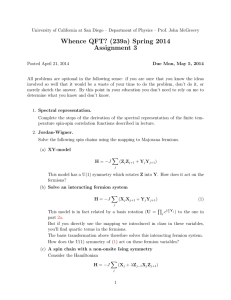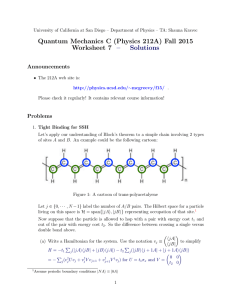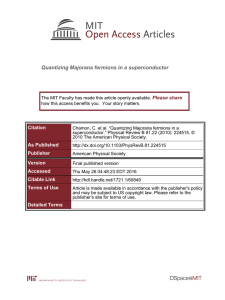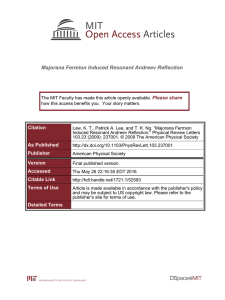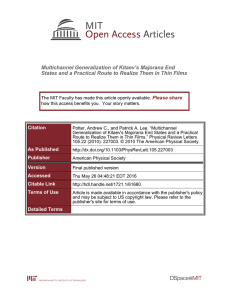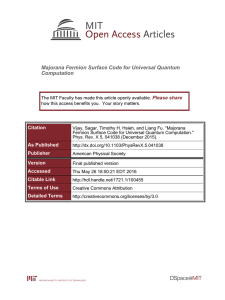Whence QFT? (239a) Spring 2014 Assignment 3 – Solutions
advertisement
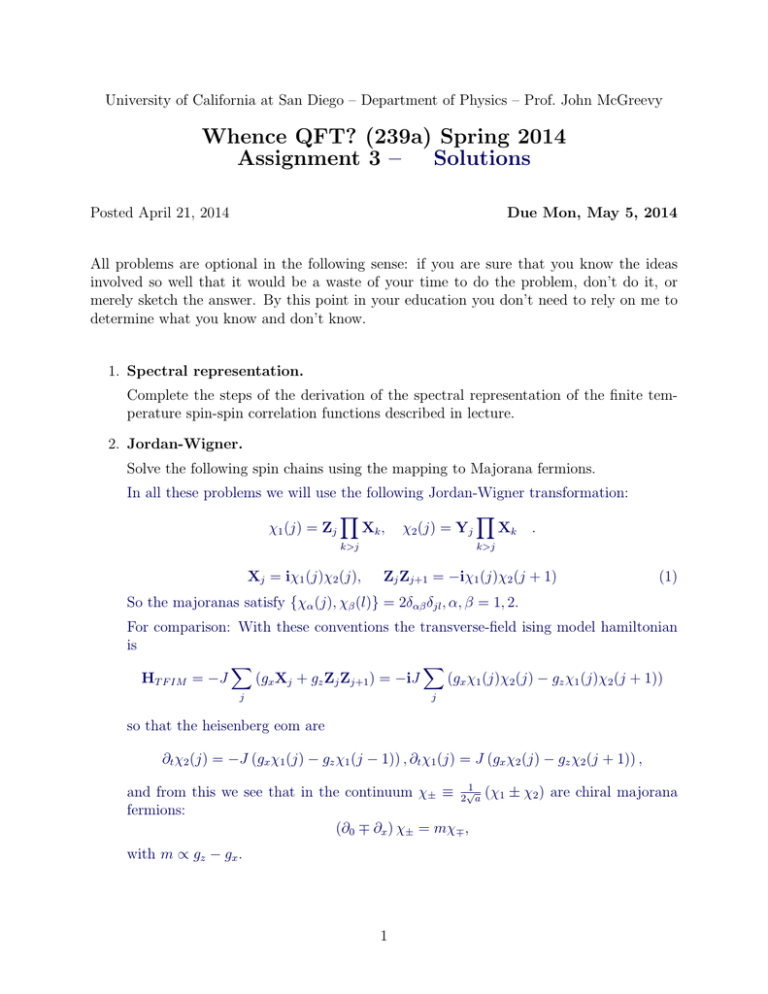
University of California at San Diego – Department of Physics – Prof. John McGreevy
Whence QFT? (239a) Spring 2014
Assignment 3 –
Solutions
Posted April 21, 2014
Due Mon, May 5, 2014
All problems are optional in the following sense: if you are sure that you know the ideas
involved so well that it would be a waste of your time to do the problem, don’t do it, or
merely sketch the answer. By this point in your education you don’t need to rely on me to
determine what you know and don’t know.
1. Spectral representation.
Complete the steps of the derivation of the spectral representation of the finite temperature spin-spin correlation functions described in lecture.
2. Jordan-Wigner.
Solve the following spin chains using the mapping to Majorana fermions.
In all these problems we will use the following Jordan-Wigner transformation:
Y
Y
χ1 (j) = Zj
Xk , χ2 (j) = Yj
Xk .
k>j
Xj = iχ1 (j)χ2 (j),
k>j
Zj Zj+1 = −iχ1 (j)χ2 (j + 1)
(1)
So the majoranas satisfy {χα (j), χβ (l)} = 2δαβ δjl , α, β = 1, 2.
For comparison: With these conventions the transverse-field ising model hamiltonian
is
X
X
HT F IM = −J
(gx Xj + gz Zj Zj+1 ) = −iJ
(gx χ1 (j)χ2 (j) − gz χ1 (j)χ2 (j + 1))
j
j
so that the heisenberg eom are
∂t χ2 (j) = −J (gx χ1 (j) − gz χ1 (j − 1)) , ∂t χ1 (j) = J (gx χ2 (j) − gz χ2 (j + 1)) ,
and from this we see that in the continuum χ± ≡ 2√1 a (χ1 ± χ2 ) are chiral majorana
fermions:
(∂0 ∓ ∂x ) χ± = mχ∓ ,
with m ∝ gz − gx .
1
(a) XY-model
H = −J
X
(Zj Zj+1 + Yj Yj+1 )
j
I find
H = −J
X
(iχ2 (j)χ1 (j + 1) − iχ1 (j)χ2 (j + 1))
j
H = −J
X
i (χ2 (j)χ1 (j + 1) + χ2 (j + 1)χ1 (j))
j
In fourier space,
1
χα (j) = √ e−ikaj χα (k)
N
we get
H = +iJ
X
χ1 (k)χ2 (−k)2 cos ka = +
k
X
(2J cos ka)c†k ck
k
1
2
where ck ≡ (χ1 (k) + iχ2 (−k)). (Beware my factors of two here.)
This model has a U(1) symmetry which rotates Z into Y. How does it act on the
fermions?
The U(1) acts by
c → eiθ c.
(b) Solve an interacting fermion system
Hint = −J
X
(Xj Xj+1 + Yj Yj+1 )
(2)
j
Q π
This model is in fact related by a basis rotation (U = j ei 4 Yj ) to the one in
part 2a.
But if you directly use the mapping we introduced in class in these variables,
you’ll find quartic terms in the fermions.
The basis transformation above therefore solves this interacting fermion system.
Hint = −J
X
(iχ1 (j)χ2 (j)iχ1 (j + 1)χ2 (j + 1) + iχ2 (j)χ1 (j + 1))
j
In terms of the complex fermions, iχ1 (j)χ2 (j) = 1 − 2c†j cj = 1 − 2nj this first
term is a near-neighbor density-density interaction, ∝ nj nj+1 .
How does the U(1) symmetry of (2) act on these fermion variables?
It mixes particles and holes.
(c) A spin chain with a non-onsite Ising symmetry
Consider the Hamiltonian
X
H = −J
(Xj + λZj−1 Xj Zj+1 )
j
2
i. (Slightly more optional:) Show that when λ = −1 this model is invariant
under the action of
Y
Y π
S1 ≡
Xj
ei 4 Zj Zj+1 .
j
j
This symmetry is “not-onsite” in that its action on the spin at site j depends
on the state of the neighboring sites.
ii. Solve this model by Jordan-Wigner. Show that the spectrum is gapless and
that each momentum state is doubly-degenerate.
The chain falls apart into two decoupled pieces, since the ZXZ term only
couples odd sites to odd sites and even sites to even sites. Hence the doubling
of the spectrum.
iii. [Challenge problem] The previous part shows that this model produces two
massless majorana fermions of each chirality. Find the action of the ZZ2
symmetry on these fermions.
iv. P
[Challenge problem] Consider the effect of adding the ferromagnetic term
j Zj Zj+1 on this system. Is it invariant under the symmetry?
Majorana fermion solution of edge Hamiltonian with non-onsite ZZ2
symmetry.
In this problem we consider adding an extra term:
X
H2 = −J
(gx Xj + gz Zj Zj+1 + g̃x Zj−1 Xj Zj+1 ) .
j
When g̃x = −gx , this hamiltonian has the symmetry
!
!
Y
Y
S1 =
eiQl,l+1
Xj
j
where eiQl,l+1 =
I claim that
l
√
iπ
Zl Zl+1 = e 4 (1−Zl Zl+1 ) .
Zj−1 Xj Zj+1 = −iχ1 (j − 1)χ2 (j + 1) .
So this hamiltonian is
X
H2 = −iJ
(gx χ1 (j)χ2 (j) − (gz χ1 (j) − g̃x χ1 (j − 1)) χ2 (j + 1)) .
j
This has the same continuum eom as the usual TFIM model with the replacements: gz → gz + g̃x and double the velocity. So the critical point is now at
0 = gz − g̃x − gx .
Let’s understand the symmetry action on the fermions.
The trivial symmetry action is
Y
Y
χ1 (j)χ2 (j).
S0 =
Xj = iN
j
j
3
This acts as
S0 χα S†0 = −χα ,
which is indeed a symmetry of HTFIM .
Using (1), the additional factors in S1 can be written as:
iπ
iπ
π
eiQl,l+1 = e 4 (1+iχ1 (j)χ2 (j+1)) = e 4 ei 4 iχ1 (j)χ2 (j+1)
iπ
iπ 1 − χ1 (j)χ2 (j + 1)
π
π
√
= e 4 cos + i sin iχ1 (j)χ2 (j + 1) = e 4
.
4
4
2
Notice that this object is indeed unitary:
†
1 − ab 1 − ab
1 − ab 1 + ab
1
√
√
√
= √
= (1 − ab + ab − abab) = 1 .
2
2
2
2
2
Acting this on χα (j) gives
?
S1 χ1 (j)S†1 = −χ2 (j + 1) .
(3)
?
S1 χ2 (j)S†1 = χ1 (j − 1) .
Q
The key step (the only factor in j eiQ that matters) comes from
1 ± χ1 (j)χ2 (j + 1)
1 ∓ χ1 (j)χ2 (j + 1)
√
√
χ2 (j + 1)
= ±χ1 (j).
2
2
The essential fact here is the identity:
1 ± ab 1 ∓ ab
√ b √
= ±a,
2
2
1 ± ab 1 ∓ ab
√ a √
= ∓b,
2
2
for any two distinct majorana modes a, b. So S1 seems to act like
0 −T
T† 0
where T is the shift-by-1 operator and the matrix is acting on the α, β space.
Notice that this does not seem to square to 1! Rather it squares to the operation
which reverses the sign of all the majoranas. In the spin chain, this is a gauge
symmetry: the sign of the fermion operators is not observable. So there is no
contradiction.
Since
(3)
Zj−1 Xj Zj+1 = −iχ1 (j−1)χ2 (j+1) 7→ −i (−χ2 (j)) (χ1 (j)) = −iχ1 (j)χ2 (j) = −Xj
this ZZ2 action indeed preserves the form of H2 if gx = −g̃x (set gz = 0 for a
moment):
X
H?2 = −iJ
(χ1 (j)χ2 (j) − χ1 (j − 1)χ2 (j + 1)) has 0 = [S1 , H?2 ] .
j
4
In the continuum limit, if we ignore the shift, the transformation (3) is basically
χ1 → χ2 , χ2 → χ1 , which acts on χ±
S1 : χ+ → χ+ , χ− → −χ− ,
which indeed acts nontrivially only on χ− . This is a chiral symmetry.
More microscopically, it seems that we should define the chiral majoranas to be
χ± (j) ∼ χ1 (j) ± χ2 (j + 1).
Notice that this regrouping is very much like the dual jordan-wigner fermions.
That is: if I relabel my degrees of freedom as living on the links as follows:
1
1
γ1 (j + ) ≡ χ1 (j), γ2 (j + ) = −χ2 (j + 1)
2
2
then in terms of the gammas, the TFIM hamiltonian has the roles of the X and
Z terms reversed:
X
HT F IM = −iJ
(gx γ1 (j)γ2 (j + 1) − gz γ1 (j)γ2 (j))
j
which if I then rewrite in terms of new spin variables amounts to a duality
transformation, i.e. produces the original hamiltonian with the replaxement
gx /gz → gz /gx .
Addendum: The preceding discussion is correct, except: a 1d chain with only
next-nearest-neighbor hopping falls apart into two decoupled chains: odd sites
only couple to odd sites and even sites only couple to even sites. This means
we actually get two copies of the majorana with this chiral realization of the
symmetry.
In fact, the ferromagnetic term is also invariant under S1 . This is clear in terms
of the spins, since the extra phase factors commute with Zs. And in fact the extra
phase factors are made from the combination Zj Zj+1 . In terms of the majoranas,
Zj Zj+1 = −iχ1 (j)χ2 (j + 1) 7→ −i (−χ2 (j + 1)) (+χ1 (j)) = −iχ1 (j)χj (j + 1).
Adding this term will gap out the majorana fields (i.e. it adds a term in the
eom which is not proportional to k). However: here will still be two degenerate
groundstates. With an open chain, these are the dangling majorana modes at
the ends. This is because with both gz 6= 0 and g̃x 6= 0 (both of which couple j
to j + 21 ), we will always be in the regime (the ferromagnetic phase) where the
pairing is between site j and site j + 21 , leaving out the sites 12 and N + 12 .
This model is discussed in this paper by Xie Chen et al.
(d) Kitaev-honeycomb-model-like chain
Consider
X
HK =
(X2j X2j+1 + Y2j Y2j−1 )
j
5
where the bonds alternate between XX interactions and YY interactions. There
are now two sites per unit cell, which means that the solution in terms of momentumspace fermion operators will involve two bands. Find their dispersion.
HK =
X
i (−χ1 (2j)χ2 (2j + 1) + χ2 (2j)χ1 (2j − 1))
j
Introduce fourier modes for the bravais lattice with two sites (hence four majoranas) per unit cell
χ1 (2j)
χ2 (2j + 1)
= √1 eik(2ja) χA (k)
χ1 (2j + 1)
N
χ2 (2j)
whose hamiltonian is
HK =
X
iχA (k)χB (−k)tAB (k)
k
with
0
e−ika
tAB (k) =
0
0
eika 0
0
0
0
0
0 −1
0
0
1
0
Since the bottom block of this matrix doesn’t depend on k, one of the bands is
flat.
6
